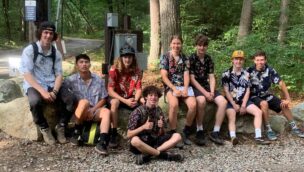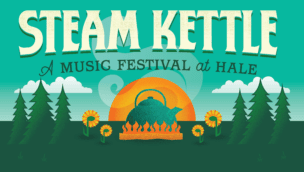Why Our Trails Are in Jeopardy

They run like ribbons through our landscape, meandering past meadows and shorelines, or vanishing into a thicket of trees. Some are rugged, taking us from mountain tops to canyon bottoms. Others are historic, giving us a look into our past, and perhaps offering a glimpse of our future.
Trails connect us to each other and to the world around us. They are our lifeline to the outdoors, our link to nature, and our chance for solitude in an often chaotic world. Whether blazed by people or animals, trails play an important role in all our lives — even if we’ve never hiked, biked, ran, skied, or ridden a horse on one.
“Trails bring communities together, whether they are cities in Greater Boston or rural communities,” says Leo Roy, commissioner of the Massachusetts Department of Conservation and Recreation, the agency that manages the Commonwealth’s nearly 4,000 miles of trails set on 500,000 acres. Add to that the miles of publicly available trails on privately held land—including 20 miles of trails on Hale’s 1,137-acre property—along with all the paths maintained by local governments and The Trustees, a conservation nonprofit.
Together, they make up one of the most extensive trail systems in all of New England. No matter what kind of outdoor enthusiast you are, Massachusetts has a trail for you. Whether it’s Boston’s historic Freedom Trail that draws tourists from across the country, the Skyline Trail at Blue Hills Reservation with its panoramic views of the city, or the Cape Cod Rail Trail, one of the most popular cycling spots in the nation, trails are woven into the fabric of life in Massachusetts.
“Trails really improve the quality of life, especially in our urban areas,” Roy says of the patchwork of paths that encircles Boston. The Rose Kennedy Greenway, Millennium Park, and Franklin Park are just a few properties that compose an arc of greenery known as the Emerald Necklace. It isn’t just a getaway from the chaos of Boston’s car-filled streets and crowded sidewalks, though.
“It’s been proven being outdoors improves our health. It’s restorative to the soul,” Roy adds.
Recent research from Stanford University confirmed that exposure to nature can lower the risk of depression and anxiety and improve mood, cognitive function, and memory. Other studies found a drop in mortality rates as well as a decline in cardiovascular and respiratory diseases when people spend time in nature.
“There’s a lot of evidence that being in nature plays an important part in being healthy,” says Stephen Sloan, owner of Open Space Results, LLC, a land management firm in Belmont. “The natural environment can be invigorating and soothing…it allows us to slow down from our fast-paced lifestyles.”
Richard O’Brien, owner of the land protection and management firm Conservation Works, says establishing a connection with nature “helps us live a fuller, more enjoyable life.”
Westwood resident Richard de Reyna couldn’t agree more. When he bought a house near Hale 22 years ago, he began walking its trails, first with his two young sons and later with the boys’ scout troop.
“It was unstructured play for them,” he says. “They would lift up rocks and play with leaves. It was such a wonderful way to engage kids in the outdoors.”
de Reyna credits those hikes for a trove of memories, but also for igniting a passion that led him to scale the highest peaks in New England, travel a 100-mile path in Scotland, and hike trails in Kenya.
“It’s a super activity,” de Reyna adds, rattling off a list of benefits that include exercise, fresh air, a chance to notice seasonal changes, and the ability to clear your mind of problems and stress. It even serves as a social network of sorts, allowing hikers to interact with others on the trail, rather than behind a screen. “I wouldn’t trade it for gym time—ever.”
D. A. Hayden manages a portion of the 117 reservations owned by The Trustees, the largest land conservation agency in Massachusetts and the oldest in the country. “The trails really foster a shared community,” says Hayden. “People who use trail networks get to meet others.”
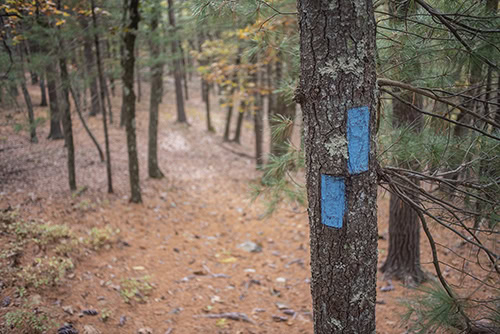
Yet despite all of these positive aspects, trails across the country are facing a crisis years in the making.
Widespread construction is taking away green space that once defined cities and suburbs, advocates say. To prevent that, some private property owners have put conservation restrictions on their properties to prevent them from being developed in the future. Others, like Hale, rely on donors, volunteers, and program revenue to maintain solvency and protect open space for future generations.
Communities have also stepped up to save open spaces. Many are buying large tracts of land to spare them from development.
The town of Walpole purchased two former farms, Adams Farm and Jarvis Farm, and turned them into public spaces where residents can walk along open trails that stretch for miles. Sudbury purchased Camp Sewataro’s 44 acres for $11 million, and Middleton plans to buy and preserve 23 acres of a golf course. Others are following suit throughout Massachusetts.
These purchases will spare some green space from development, but still more needs to be done according to conservationists. They argue that maintenance must not be forgotten.
“Many cities in Massachusetts are pretty savvy about development and trails,” says Kristen Sykes, director of conservation strategies for the Appalachian Mountain Club. “They can work with developers to say we want you to have a trail as part of this development.”
Developers are getting the message. Today, many are starting to incorporate trails into their designs. Those who do are finding that adding trails to a community means higher property values and quicker sales and resales. And owners love it.
“For all demographics, it’s a huge amenity,” says Sykes.
It can also lead to economic success for some municipalities, O’Brien says.
The Freedom Trail, for example, favorably impacts Boston’s economy thanks to the many history-loving tourists it attracts. In Milton, Blue Hills Reservation attracts city dwellers who love hiking and skiing. In Sturbridge, hikers can check out the Grand Trunk Trail, which follows an old unfinished railroad that is part of a larger system dubbed the “Titanic Rail Trail.” Even further west, towns along the Appalachian Trail host countless hikers as they trek from Georgia to Maine.
“Trails entice people to come to Massachusetts and spend their recreational dollars,” O’Brien notes. “That helps improve and create a [high] quality of life.”
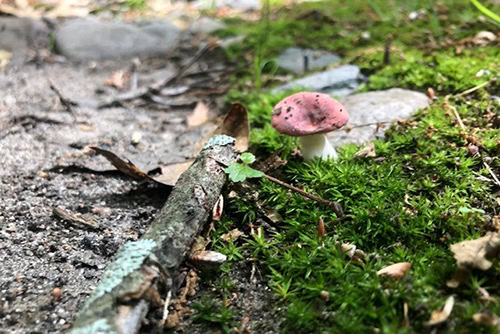
Even so, not every wild space can save itself from development. Other forces are weighing even more heavily on the state’s trail system.
Federal funding to create, maintain, and clear trails of fallen trees and overgrown vegetation is dwindling. Under the Federal Highway Administration’s Recreational Trails Program, $82 million in funding has remained stagnant for the last three years, and that figure was already down approximately $14 million from its high of $96 million in 2011.
Privately funded nonprofit trail advocacy groups report that while donors are supportive, the money they provide is rarely sufficient for proper trail maintenance.
“Funding is always an issue. It takes a lot of volunteers and a lot of money to maintain trails,” says Hayden.
Yet even with a $5 million appropriation in 2018—the largest amount ever dedicated to trails in Massachusetts—that money is only enough to fund construction and maintenance of 71 trail-related projects. And despite an additional $25 million environmental bond bill that Governor Baker’s pro-trails administration hopes will link multi-user rail trails, the money still doesn’t come close to achieving the ultimate goal of linking all the trails in the state system. That goal, some say, is years, if not decades, away.
Still, any improvements (especially along the region’s abandoned railroad easements, like the popular Cape Cod Rail Trail) are much appreciated, says O’Brien.
“The state has recognized, very correctly, that these rail trails are not only recreational. They are a critical and important means of transportation. They are getting cars off the road and getting bikes and skates and shoes on the trail. It’s a positive thing,” he says.
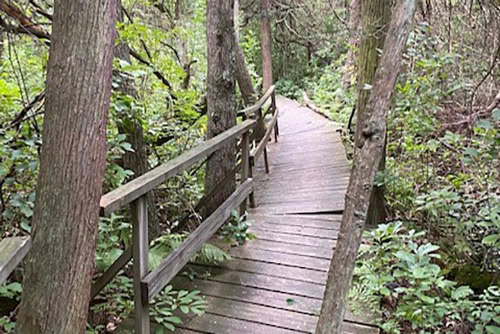
Sometimes, however, money isn’t the solution. A lack of funding is just one of many problems our trails face.
Take, for instance, the conflicting demands from different user groups whose competing interests complicate trail management. With bikers, hikers, runners, dog walkers, horseback riders, cross-country skiers, hunters, ATV riders, and others often using the same trails, resolving differences requires a significant amount of diplomacy.
“We really try to encourage a share-the-trail mentality,” says Mike Francis, a stewardship manager with The Trustees, whose properties serve more than one million visitors annually.
To encourage that mindset, the state erects signs reminding trail users to be considerate of others using the trail—even those using it for a different purpose, Roy says.
The conflicting demands of different users can sometimes manifest in damaging ways.
One of those ways, says O’Brien, is in the proliferation of unauthorized trail construction.
“Many people who use these types of trails aren’t educated [about trail construction and use] or lack the experience to design a proper trail, so a lot of these trails are unsustainable,” he says. “They are not ecologists…frankly, they don’t know what they’re doing and it causes problems.”
Those problems, O’Brien says, can cause trails to collapse or send runoff into areas that are susceptible to erosion. Even worse, many of these unauthorized trails cut through fragile environments that are home to several endangered species. Plants, insects, turtles, and salamanders have already been affected, he says.
“If you destroy clumps of milkweed, you destroy native pollinators and that impacts our existence,” O’Brien notes. “When you impact those layers of the food web, you impact the entire network.” In other words, a poorly cut trail doesn’t just affect a plant or an animal. It negatively affects everything connected to it.
Volunteers, he says, have attempted to remove unauthorized trails by replanting native foliage, but when they return to such areas, unauthorized trails have often been rebuilt.
“We’ve tried everything,” says a frustrated O’Brien. “We’ve tried educating people, posting signage, eliminating trails, restoring habitats, all without success. We’re still fighting those battles, and they’re not easy to win.”
There are still more battles ahead, conservationists predict. Among them lies the biggest: getting volunteers interested in trails and their upkeep.
“There are many different issues, but in my opinion, the single biggest one is recruiting the next generation of trail stewards,” says O’Brien. “If we spend all of this money making new trails but we don’t have a dedicated corps of volunteers to maintain them over the next 200 years, what’s the sense of spending the money? We need to begin training and recruiting that next generation of trail stewards and get them hooked on the benefits of trails for themselves, their families, and their communities.”
Today, many conservation volunteers who help clear storm damage, replant vegetation, repair boardwalks, and replace trail markings are retirees who are unable to complete the more physically demanding work that full-fledged trail maintenance requires.
Sykes, who works with the Bay Circuit Trail, said youth programs are instrumental in getting kids involved.
“There are many avenues to get kids outside,” she says.
Hale supports youth interest in trails by way of its programs. From orienteering activities to community hikes to partnerships with schools and towns, it is decidedly committed to developing the next generation of outdoor enthusiasts.
Getting people outside on those rambling paths is just the beginning. Developing a deep love of nature, an interest in wildlife, and an understanding of the seasons also creates a sense of responsibility for those green spaces that could turn the trail users of today into the conservationists, donors, and volunteers of tomorrow.
This article originally appeared in the 2019 issue of Hale Magazine. As of 2024, Hale’s total property size stands at over 1,200 acres. With the exception of Sen Ki and a small parcel in Dover, its space is currently unprotected from development.


